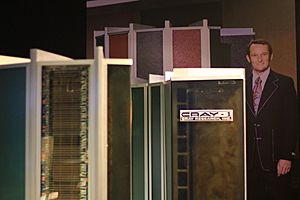Seymour Cray facts for kids
Quick facts for kids
Seymour Cray
|
|
|---|---|
| Born |
Seymour Roger Cray
September 28, 1925 |
| Died | October 5, 1996 (aged 71) |
| Alma mater | University of Minnesota |
| Known for | Supercomputers |
| Scientific career | |
| Fields | Applied mathematics, computer science, and electrical engineering |
| Institutions | Engineering Research Associates Control Data Corporation Cray Research Cray Computer Corporation SRC Computers |
Seymour Roger Cray (born September 28, 1925 – died October 5, 1996) was an American electrical engineer. He was a brilliant supercomputer designer. He created computers that were the fastest in the world for many years. He also started a company called Cray Research, which built many of these amazing machines.
People often call Seymour Cray "the father of supercomputing." He is known for creating the entire supercomputer industry. A technology expert named Joel S. Birnbaum once said that it's hard to describe how much Cray influenced the computer world. Larry Smarr, another expert, called Cray the "Thomas Edison of supercomputing."
Contents
Early Life and Learning
Seymour Cray was born in 1925 in Chippewa Falls, Wisconsin. His father was a civil engineer who helped Seymour become interested in science and building things. When Seymour was just ten years old, he built a machine from an Erector Set. This machine could turn punched paper tape into Morse code signals. His family even let him use the basement as his own "laboratory."
After finishing Chippewa Falls High School in 1943, Cray joined the military for World War II. He worked as a radio operator in Europe and then helped break Japanese naval codes in the Pacific. When he returned to the United States, he went to the University of Minnesota. He earned a degree in electrical engineering in 1949 and another in applied mathematics in 1951.
Building a Career in Computers
Engineering Research Associates
In 1950, Cray started working at Engineering Research Associates (ERA) in Minnesota. ERA was a company that grew from a US Navy lab that built code-breaking machines. Cray quickly became known as an expert in digital computers. He helped design the ERA 1103, which was the first successful computer for science. He stayed at ERA even when it was bought by other companies like Remington Rand and Sperry Corporation.
Control Data Corporation
Later, Cray and a colleague named William Norris were not happy with Sperry Rand (which owned ERA). So, in 1957, they started their own company called Control Data Corporation.
By 1960, Cray had designed the CDC 1604. This was an improved and cheaper version of the ERA 1103. It performed very well for its price. Even as the CDC 1604 was being sold, Cray was already thinking about new designs. He wanted to build "the largest [fastest] computer in the world." He didn't enjoy working on slower, cheaper machines for businesses. So, he focused on designing the CDC 6600.
Cray put a lot of effort into making the CDC 6600 as fast as possible. He understood that a computer's speed wasn't just about the main processor. It also needed to move data in and out very quickly. He famously said, "Anyone can build a fast CPU. The trick is to build a fast system."
The CDC 6600 became the first commercial supercomputer. It was much faster than any other computer available at the time. While it was expensive, it was the best choice for anyone who needed extreme speed. Cray solved a big design problem in the 6600. He used smaller, built-in mini-computers to handle data transfers. This made the main processor much more efficient. The next computer, the CDC 7600, was five times faster than the 6600!
Cray's Lab in Chippewa Falls
As Control Data Corporation grew, Cray felt that too many managers were bothering him. He wanted a quiet place to work without interruptions. So, he decided to move his work far away from the company's main offices in St. Paul. He chose to set up a new lab on his own land in his hometown of Chippewa Falls. This new lab was far enough away to discourage quick visits but close enough for important meetings. Cray even built a large bomb shelter at his house near the new lab.
The new Chippewa Lab was built while the CDC 6600 project was still going on. After the 6600 was released, the CDC 7600 was developed there. It was ten times faster than the 6600. However, the next project, the CDC 8600, faced many problems. Cray wanted to start over with the 8600, but the company's management didn't want to take the risk. They preferred another project, the CDC STAR-100. Because of this, Cray decided to leave Control Data Corporation in 1972.
Cray Research
Cray left CDC on good terms. A year later, he started his own company, Cray Research. He set up his new lab on the same property in Chippewa Falls. The company's main offices were in Minneapolis, but all the computer manufacturing happened in Chippewa Falls.
At first, people wondered if the new company could afford to build a new computer. But Cray's reputation was so strong that investors were eager to give him money.
After several years of hard work, their first product was released in 1976. It was called the Cray-1. Like his earlier designs, the Cray-1 was fast in every part, not just the main processor. When it came out, it easily beat almost every other computer in speed. The company thought they might sell about a dozen Cray-1s. But they ended up selling over 80! This made Cray Research a huge financial success. Cray's amazing work earned him the nickname "The Wizard of Chippewa Falls."
His next projects were more challenging. While he worked on the Cray-2, other teams at Cray Research created the Cray X-MP. The X-MP was a big success. When the Cray-2 was finally released after six years, it was only a little faster than the X-MP. So, fewer Cray-2s were sold.
As the Cray-3 project began, Cray felt he was being bothered too much by daily company tasks. To focus on designing, he stepped down as CEO of Cray Research in 1980. He became an independent contractor. In 1988, he moved the Cray-3 project to a new lab in Colorado Springs, Colorado.
In 1989, the Cray-3 project ran into problems, just like the 8600 had years before. Company management had to choose between the struggling Cray-3 and a promising new design called the Cray Y-MP. They chose the safer option, the Y-MP.
Cray Computer Corporation
Cray decided to create a new company called Cray Computer Corporation. This new company took over the Cray-3 project.
The 500 MHz Cray-3 turned out to be Cray's second major failure. To make it ten times faster than previous machines, Cray decided to use new gallium arsenide parts. Usually, Cray preferred to use well-known technology and make it fast through clever design. But this time, he was developing almost every part of the machine, including the chips.
Even with these challenges, the team got the machine working. They delivered the first one to NCAR on May 24, 1993.
However, the Cray-3 was still like a test model. At the same time, many new massively parallel computers were coming out. These computers offered great performance for their price. Cray tried to respond by designing the Cray-4, which would be even faster. But by 1995, no more Cray-3s had been sold. The company ran out of money and went bankrupt on March 24, 1995.
SRC Computers
Cray had always believed that one very fast processor was better than many smaller ones working together. He famously joked, "If you were plowing a field, which would you rather use: two strong oxen or 1024 chickens?" But by the mid-1990s, massively parallel computers were becoming very good. It was also easier to write programs for them.
So, Cray started a new company called SRC Computers. He began designing his own massively parallel machine. This new design focused on how data moved and was stored, which was a common problem for parallel computers. Cray had just started this design when he sadly died in a car accident. SRC Computers continued his work and now specializes in reconfigurable computing.
Cray's Design Ideas
Cray often talked about two key ideas in his computer designs:
- Removing heat: His computers had special cooling systems. These included channels for coolant inside the computer frames and metal plates in the circuit boards. He even told a story about a customer whose computer froze because the cooling system kept running after the computer shut down!
- Timing signals: He made sure that all electrical signals arrived at their destination at the exact same time. He would even make the wires on circuit boards longer by running them back and forth. This ensured all signals traveled the same distance.
When asked what tools he used to design the Cray-1, Cray said he liked #3 pencils and graph paper. He even suggested using the back of the paper so the lines weren't too bright.
Personal Life
Seymour Cray didn't like being in the public eye. There are many interesting stories about his life outside of work. He enjoyed skiing, windsurfing, tennis, and other sports. He also loved digging a tunnel under his home. He joked that "elves" would visit him in the tunnel and give him ideas for his computer problems!
One story says that when managers asked him for detailed plans for his next computer, he simply wrote: "Five-year goal: Build the biggest computer in the world. One year goal: One-fifth of the above." Another time, when asked for a long status report, he wrote only two sentences: "Activity is progressing satisfactorily as outlined under the June plan. There have been no significant changes or deviations from the June plan."
Cray died on October 5, 1996, after a car accident.
The IEEE Computer Society created the Seymour Cray Computer Engineering Award in his honor. This award celebrates new ideas in high-performance computing, just like Cray's creative spirit.
Cray married Verene Voll in 1947. They had three children and later divorced around 1978. He then married Geri Harrand and had one son and two daughters.
See also
 In Spanish: Seymour Cray para niños
In Spanish: Seymour Cray para niños
- Charles Babbage Institute
- Cray-3/SSS
- John Vincent Atanasoff



